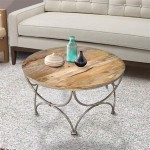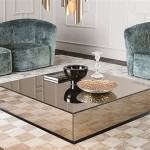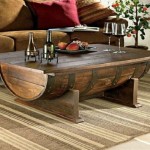Should a Coffee Table Be Lower Than the Couch? Determining Optimal Height for Function and Aesthetics
The relationship between a coffee table and a couch within a living space transcends mere furniture placement; it involves a careful consideration of ergonomics, functionality, and the overall aesthetic balance of the room. A common question that arises during this planning process is whether the coffee table should be lower than the couch. While there isn't a single, universally applicable rule, understanding the reasoning behind this question and exploring various factors that influence the optimal height will lead to a more informed decision.
The primary purpose of a coffee table is to provide a convenient surface for placing beverages, books, remote controls, and other items within easy reach of those seated on the couch. Therefore, the height is intrinsically linked to the comfort and usability of the seating arrangement. If the coffee table is too high, it can feel imposing and obstruct sightlines. Conversely, if it's too low, it can be awkward to reach and may not adequately serve its intended purpose. This article will delve into the nuances of determining the ideal height relationship between a coffee table and a couch, considering practical implications and design principles.
Ergonomics and Reachability: The Practical Considerations
One of the most significant factors influencing the ideal coffee table height is ergonomics. The height should facilitate comfortable reach while seated. A table that forces individuals to lean excessively or strain their backs to retrieve items is clearly not ergonomically sound. The average height of a couch seat, measured from the floor to the top of the seat cushion, typically falls within the range of 16 to 20 inches. The coffee table should ideally be at the same height as the seat cushion, or slightly lower. This is the established standard, ensuring easy access without undue strain.
Having a coffee table at the same height as the couch seat allows individuals to easily place and retrieve items without having to bend over significantly. This is especially important for those who frequently use the coffee table for activities such as eating, working on a laptop, or playing games. A table that is slightly lower, perhaps one or two inches below the seat cushion, can also be acceptable, as it generally doesn't compromise reachability while maintaining a visually pleasing proportion.
However, significant deviations from this height range can lead to discomfort and inconvenience. A coffee table that is several inches lower than the couch seat requires a more pronounced bending motion, which can be problematic for individuals with back issues or mobility limitations. On the other hand, a table that is significantly higher can feel obstructive and visually jarring, impacting the overall comfort and flow of the living space.
The key is balance. If the primary function of the coffee table is for casual use – holding drinks and remote controls – then a slightly lower height may be preferable for aesthetic reasons. But if the table is frequently used for more involved activities, maintaining a height closer to the seat cushion is crucial for ergonomic comfort.
Aesthetics and Visual Harmony: The Design Perspective
Beyond functionality, the height relationship between a coffee table and a couch also plays a crucial role in the aesthetics of the room. The proportions and visual balance between these two key furniture pieces contribute significantly to the overall design harmony. A well-chosen coffee table height can enhance the room's visual appeal, while an inappropriate height can disrupt the flow and create a sense of imbalance.
As a general design principle, a coffee table that is lower than the couch tends to create a more relaxed and inviting atmosphere. The lower profile allows for better sightlines across the room, making the space feel more open and airy. This is particularly beneficial in smaller living rooms where maximizing the perception of space is essential. A higher coffee table can, on the other hand, feel more formal and structured, potentially making the room feel more confined, especially if the couch is already substantial in size.
The style of the couch and coffee table also influences the ideal height relationship. For example, a modern, low-slung couch may be best complemented by a coffee table that is similarly low in profile. This creates a cohesive and streamlined look that aligns with minimalist design principles. In contrast, a more traditional couch with a higher seat height might pair well with a coffee table that is closer in height to the seat cushion, maintaining a sense of proportion and balance that is characteristic of classic design aesthetics.
Consider the other elements in the room, such as area rugs, lighting fixtures, and wall decor. The coffee table should not only complement the couch but also integrate seamlessly with the overall design scheme. The height of the coffee table can influence how these other elements are perceived, impacting the visual cohesion of the entire space. A strategically chosen height can help to anchor the room and create a sense of visual harmony.
Ultimately, the aesthetic consideration is subjective and depends on the desired ambiance and design style. However, understanding the principles of proportion and visual balance can guide the decision-making process and help to create a living space that is both functional and aesthetically pleasing.
The Role of Coffee Table Style and Functionality
The specific style and intended functionality of the coffee table itself significantly influence the optimal height. Different styles offer varying dimensions and design characteristics, each impacting the overall aesthetic and usability of the space. Furthermore, the intended use of the coffee table—whether primarily for display, storage, or active use—will dictate the most appropriate height.
A low-profile coffee table, often seen in modern or minimalist designs, tends to be lower than the average couch seat height. These tables prioritize a sleek and uncluttered look, typically serving as a subtle accent piece rather than a primary surface for activities. They are ideal for displaying decorative items or holding a few essential items, but may not be suitable for frequent use in activities like eating or working.
On the other hand, a coffee table with built-in storage, such as drawers or shelves, may require a slightly higher profile to accommodate the storage compartments. These tables often function as multi-purpose pieces, providing both a surface for items and a convenient storage solution. The height may need to be adjusted to balance the storage capacity with the ergonomic considerations of reachability and comfort.
Furthermore, consider the material and construction of the coffee table. A solid wood coffee table may have a different visual presence than a glass or metal table, influencing how the height is perceived. A larger, more substantial coffee table might benefit from a slightly lower height to avoid feeling too imposing, while a smaller, more delicate table might benefit from a height closer to the seat cushion height to provide adequate surface area.
The shape of the coffee table also plays a role. A round coffee table, for example, may appear more visually balanced at a slightly different height than a rectangular or square table. The shape influences the perception of space and the overall flow of the room, and the height should be chosen to complement the shape and create a harmonious design.
Ultimately, the style and functionality of the coffee table should be carefully considered when determining the optimal height. The table should not only complement the couch and the overall design of the room but also serve its intended purpose effectively and comfortably.
In conclusion, while a lower coffee table than the couch is a common guideline, the specific optimal height is multifactorial, dependent on ergonomics, aesthetics, and the coffee table’s style and functionality. Considering these aspects ensure a living space that is both visually appealing and functionally sound.

How To Buy A Coffee Table Living Spaces

The Ultimate Coffee Table Size Guide Apt2b
:strip_icc()/cdn.cliqueinc.com__cache__posts__268833__how-to-choose-a-coffee-table-268833-1538077811019-image.700x0c-7a56fb07e0084a48b51032071b7fa87b.jpg?strip=all)
Don T Make This Living Room Coffee Table Mistake

Should A Coffee Table Be Higher Or Lower Than Sofa

Can A Coffee Table Be Higher Than Couch

Guide To Coffee Table Height Size Get The Right For Your Room Housist

10 Simple Steps To Picking Your Ideal Coffee Table
.jpg?strip=all)
Should A Coffee Table Be Higher Or Lower Than Sofa
:strip_icc()/cdn.cliqueinc.com__cache__posts__268833__how-to-choose-a-coffee-table-268833-1538077812941-image.700x0c-2d7e3eba58fa49d096256032f2f6381a.jpg?strip=all)
Don T Make This Living Room Coffee Table Mistake

How To Choose The Right Size Shape Coffee Table For Your Living Space
Related Posts








